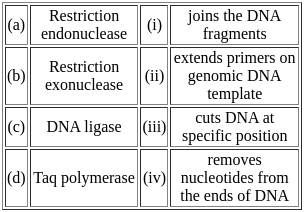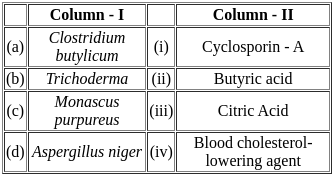Biology: CUET Mock Test - 7 - CUET MCQ
30 Questions MCQ Test - Biology: CUET Mock Test - 7
Raising crops for the production of ethanol is known as __________
The bacterium used by 'Eli Lilly', an American Company, to produce insulin chains is:
Which of the following statements regarding Genetically Modified Organisms are not correct?
(A) Crops are more tolerant to abiotic stresses
(B) Pest-resistant crops
(C) Post harvest losses are more
(D) Reduced efficiency of mineral usage by plants
Choose the correct answer from the options given below:
Select the organisms which breed once in their lifetime.
(A) Squirrel
(B) House sparrow
(C) Pacific salmon
(D) Bamboo
Choose the correct answer from the options given below:
Match the following enzymes with their functions :

Select the correct option from the following:
Match the following columns and select the correct option.

What is the significance of comparative anatomy in evolution?
What does the presence of similar fossils in different locations suggest?
How does the study of fossils contribute to our understanding of evolution?
Which of the following statements are correct?
(A) Genetic engineering involves the modification of an organism’s genome using recombinant DNA technology.
(B) Bt crops produce a toxin that is harmful to human beings.
(C) Tissue culture is a technique to grow plant cells in a controlled environment.
(D) Transgenic animals are used to study the effects of diseases and test new treatments.
(E) Golden rice is genetically modified to enhance its vitamin C content.
Choose the correct answer from the options given below:
Which of the following statements are correct?
(A) The first clinical gene therapy was performed in 1990 on a child with ADA deficiency.
(B) Recombinant DNA technology has been used to produce human insulin in bacteria.
(C) Somatic hybridization involves the fusion of two protoplasts from different plant species.
(D) Biotechnological applications have no ethical concerns regarding their use.
(E) Gene therapy can be used to treat hereditary diseases by correcting defective genes.
Choose the correct answer from the options given below:
Which of the following statements are correct?
(A) Bt cotton produces an insecticidal protein that targets specific pests.
(B) Gene therapy is a method of replacing defective genes to treat genetic disorders.
(C) Transgenic plants are engineered to produce higher yields but not to reduce pesticide use.
(D) Biotechnological applications include the use of microbes in the production of therapeutic drugs.
(E) Cloning involves creating genetically identical organisms by transferring genes.
Choose the correct answer from the options given below:
Which of the following statements are correct?
(A) The intrinsic rate of natural increase (r) determines the growth rate of a population.
(B) The population density is always calculated by the total number of individuals in the population.
(C) Logistic growth occurs when resources are limited, and the population stabilizes at the carrying capacity.
(D) Competition between species always results in the extinction of the weaker species.
(E) In mutualistic interactions, both species benefit from the relationship.
Choose the correct answer from the options given below:
Which disease affects the lungs and is caused by Streptococcus pneumoniae?
Which of the following processes provide both energy and manure?















